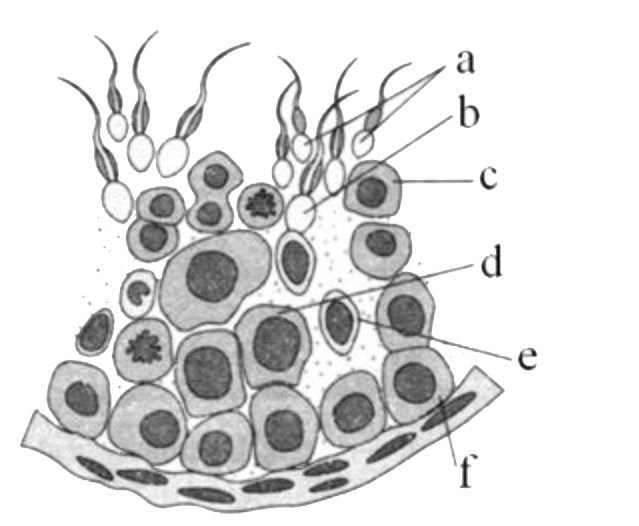How many structures are diploid ?
Sperms, spermatid, spermatogonia, primary spermatocyte, secondary spermatocyte
The correct Answer is:2 (Spermatogonia, primary spermatocyte)
To determine how many structures are diploid among the given options (sperms, spermatid, spermatogonia, primary spermatocyte, secondary spermatocyte), we can analyze each structure based on their chromosome number:
1. Spermatogonia:
- These are the germ cells in the male reproductive system.
- They are diploid, meaning they contain two sets of chromosomes (46 chromosomes or 23 pairs).
2. Spermatid:
- This is the haploid product of meiosis, meaning it contains only one set of chromosomes (23 chromosomes).
- Therefore, spermatids are not diploid.
3. Sperms:
- Sperm cells are also haploid, containing only one set of chromosomes (23 chromosomes).
- Thus, sperm cells are not diploid.
4. Primary Spermatocyte:
- This cell undergoes meiosis to form secondary spermatocytes.
- Primary spermatocytes are diploid, containing two sets of chromosomes (46 chromosomes or 23 pairs).
5. Secondary Spermatocyte:
- These are the result of the first meiotic division of primary spermatocytes.
- Secondary spermatocytes are haploid, containing only one set of chromosomes (23 chromosomes).
- Therefore, secondary spermatocytes are not diploid.
Now, summarizing the diploid structures:
- Diploid Structures:
- Spermatogonia
- Primary Spermatocyte
Thus, the total number of diploid structures is 2.
Final Answer:
2 structures are diploid: Spermatogonia and Primary Spermatocyte.
- These are the germ cells in the male reproductive system.
- They are diploid, meaning they contain two sets of chromosomes (46 chromosomes or 23 pairs).
- This is the haploid product of meiosis, meaning it contains only one set of chromosomes (23 chromosomes).
- Therefore, spermatids are not diploid.
- Sperm cells are also haploid, containing only one set of chromosomes (23 chromosomes).
- Thus, sperm cells are not diploid.
- This cell undergoes meiosis to form secondary spermatocytes.
- Primary spermatocytes are diploid, containing two sets of chromosomes (46 chromosomes or 23 pairs).
- These are the result of the first meiotic division of primary spermatocytes.
- Secondary spermatocytes are haploid, containing only one set of chromosomes (23 chromosomes).
- Therefore, secondary spermatocytes are not diploid.
- Diploid Structures:
- Spermatogonia
- Primary Spermatocyte
2 structures are diploid: Spermatogonia and Primary Spermatocyte.
Topper's Solved these Questions
Similar Questions
Knowledge Check
How many sperms are formed from a secondary spermatocyte?
A4B8C2D1

How many structures of X is possible ?
View SolutionHow many structures for F are possible
 .
.
View Solution
How many structures of F is possible?
View SolutionWhich of the following undergoes spermiogenesis :
(a) Spermatids
(b) Spermatogonia
(c) Primary spermatocytes
(d) Secondary spermatocytes
View SolutionRecognize the figure and find out the CORRECT labeling.

(a) a -spermatozoa, b - spermatid, c - primary spermatocyte , d - secondary spermatocyte , e - spermatogonia , f - sertoli cell
(b) a -spermatozoa, b - spermatid, c - secondary spermatocyte , d - primary spermatocyte - Sertoli cell , f - spermatogonia
(c) a -spermatozoa, b - spermatid, c - primary spermatocyte , d - secondary spermatocyte , e - spermatogonia , f - sertoli cell
(d) a -spermatozoa, b - spermatid, c - secondary spermatocyte , d - primary spermatocyte - Sertoli cell , f - spermatogonia
View SolutionHow many structures in the list given below are haploid?
Spermatid, secondary oocyte, primary spermatocyte, ovum, sperm, oogonia, spermatogonia, polar body
View SolutionCorrect sequence of spermatogenesis :
(a) spermatogonia
(b) spermatids
(c) primary spermatocyte
(d) secondary spermatocyte
(e) spermatozoa
View Solution
